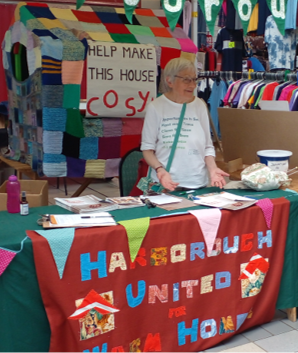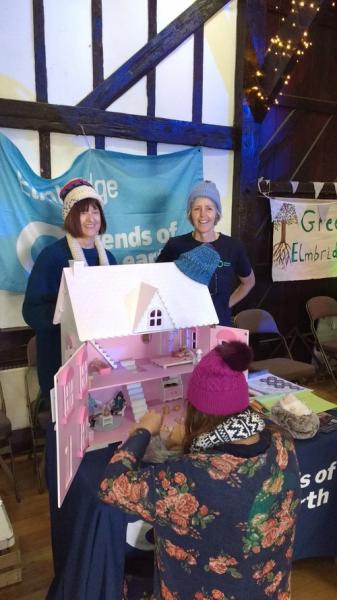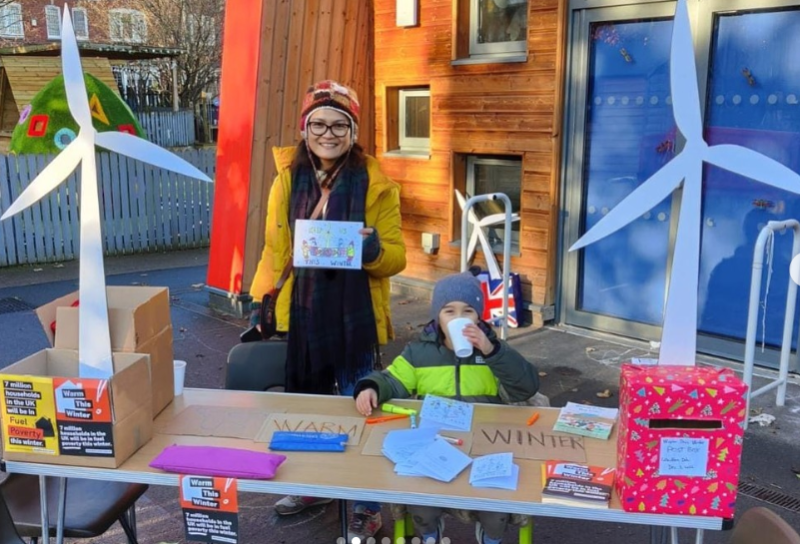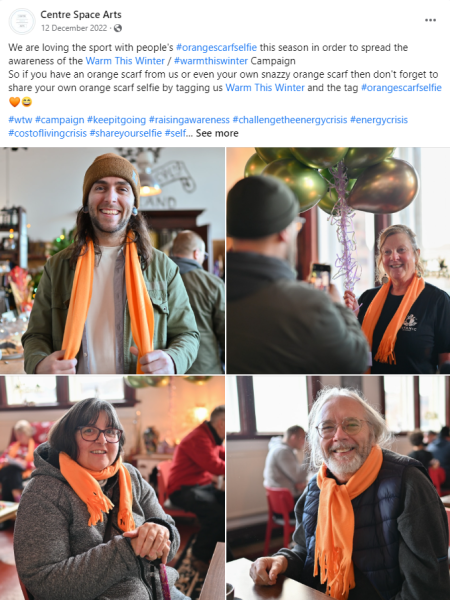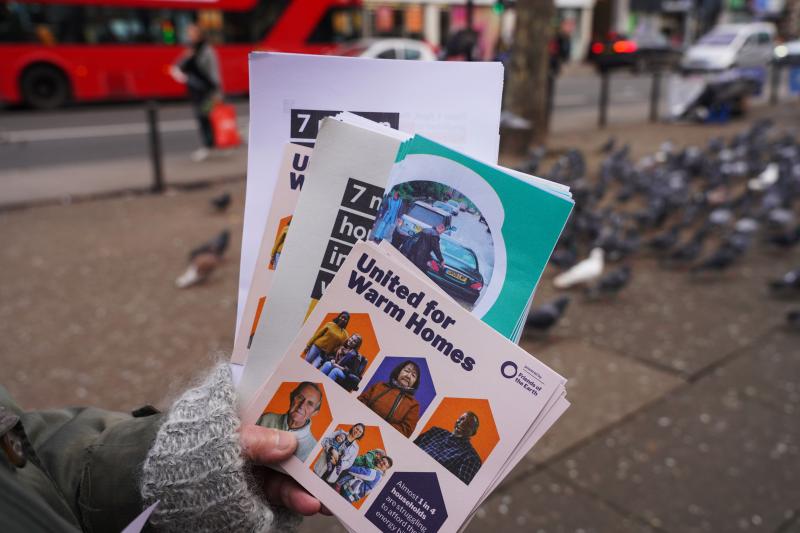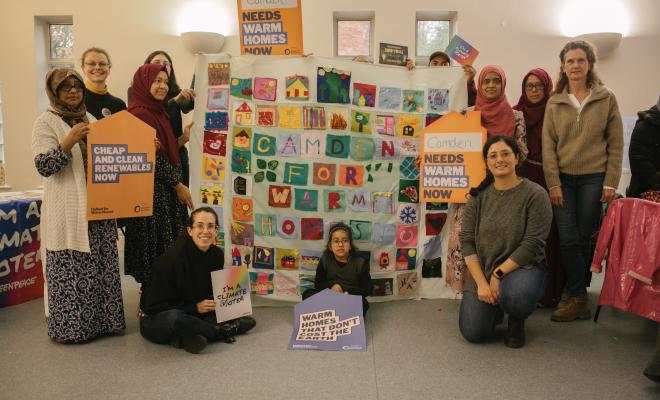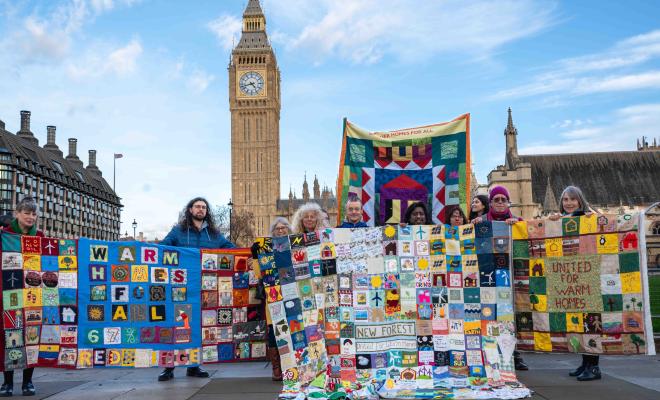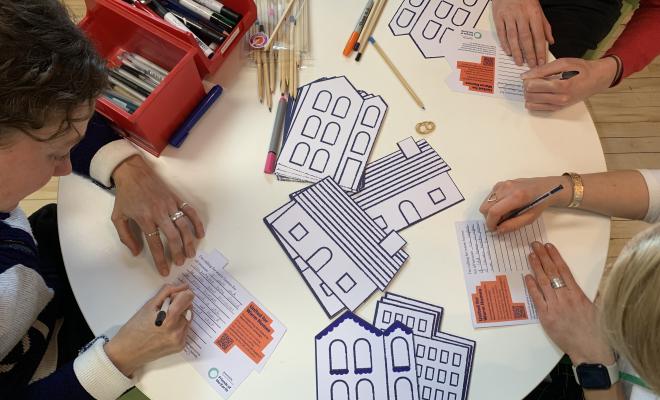26 Jan 2023
Using conversations to build essential support for your campaign will be a key part in demonstrating local interest when engaging decision makers. It also adds to our collective strength when calling on governments.
The activities we’ve listed work all year round, but you may want to adapt them based on the time of year. In winter, speaking to people about warm homes is easier as the energy crisis is at the forefront of our minds, but it’s also a harder time to organise stalls or street campaigning. In colder months, think about running indoor activities and events such as coffee mornings or craft sessions to grow the campaign while staying warm. Take a look at our events guide for more inspiration.
Interactive activities
Having creative and quick actions for passers-by to engage with can help you start conversations and get noticed. People are more likely to stop and stay engaged if there’s something for them to do, especially if it’s exciting or fun. Below are some of the different types of interactive activities you could run.
Write a postcard to decision makers
We’re turning up the pressure on MPs by sending them postcards with messages from their community, compelling them to take action on the energy crisis. This is a quick and creative action you could run on a stall.
Ask passers-by to decorate postcards and add messages explaining why they care about warm homes and why we need our politicians to urge governments to take action. We’ve created postcard templates you can order and have to hand at community events.
Crafting
Getting creative can appeal to people of all ages and be a fun and exciting thing to do while they learn more about the campaign.
A great example of this is the Harborough United for Warm Homes group, which asked the public to help make its giant house cosy and guess how many knitted squares there were too.
Create a quiz
Another interactive activity you could run is a Warm Homes quiz. This could be question cards with true or false answers, and people can flip the card over to find out if they’re right. You could have the quiz on a laptop, or they could write their answers on a handout along with their email address for you to send them the answers later. Having a laptop to hand and asking people who participate to sign up for your group updates can help you keep them engaged and grow your network.
When writing the questions, think about impactful stats, for example how much energy people could save using insulation, or the number of homes that rely on dirty gas to heat them. Look at our website for the latest facts. And bring the quiz closer to home by using our interactive heat map to get relevant local facts.
Record voice notes
Voice notes are another way of gathering messages that can be played back and used as a powerful tool to tell stories about how people are being impacted locally. Capturing different people's experiences and perspectives can be a way of building powerful anecdotal evidence from your community. These stories and quotes can then be shared with decision makers.
Props
Props can be a useful way to draw attention to you or your stall, so here are a few examples of props you could use for some inspiration.
Model houses
Having a model home on display can be a good way to demonstrate heat escaping from our homes and the need for insulation.
Elmbridge Friends of the Earth used this conversation starter on a stall at a sustainability event. “We used a doll's house as a prop for the United for Warm Homes campaign, and it proved really popular as a talking point about insulation as well as being great fun for the kids.”
You could also use a Lego house or similar as another interesting and engaging prop.
Insulation materials
Insulation is the solution, but what does it look like? By having materials on your stall table, you can give people a real, tangible sense of what insulation is and how it works.
Paper wind turbines
Another eye-catching feature on a stall, this is a very recognisable prop to help start the conversation about how we can fix our broken energy system.
Hats, scarves and blankets
You could simply display some or use them as part of an interactive activity.
Hats, scarves and blankets are an easy thing to bring from home and can make a great impression on a stall, making it more noticeable without too much work.
North Staffs Friends of the Earth took part in a day of action with the Warm This Winter coalition. As part of this, group members asked people to take an #orangescarfselfie to raise awareness of the campaign.
Handouts
Don’t forget you can order resources and have things ready to hand out for people to refer to. Our resources include:
- leaflets
- posters
- stickers
- placards.
Sharing advice on energy bills
When engaging people in our communities, we need to be aware of the real-life impacts the cost-of-living and energy crises are currently having. Our campaign is calling on the government to make long-term fixes to our failed energy system, but also to provide urgent financial support for those struggling with their energy bills.
People you speak with at your stalls and events might ask you for advice on dealing with their energy bills and saving energy at home. You can find information on accessing energy bill advice and emergency support on our website. This information is also available as a printable flyer, with space for you to add information about local support services too. This might be something you want to have available as a handout on a stall.
You may also want to provide some energy-saving tips, but it's important to remember that there's only so much individuals can do. Many people experiencing fuel poverty are facing difficult financial pressures and may not have the time or resource to make changes to their homes. That’s why our campaign message should always emphasise that the government needs to do more to address both the urgent need and the long-term solutions to the energy crisis. Discussing energy-saving tips with people who ask for them can be a great way to engage them, but make sure to ask them to call for government action too.
This campaign involves building partnerships with groups on the frontline of the cost-of-living and energy crises, like food banks and community centres. If you’ve built a relationship with partner organisations who provide direct support, you may want to speak with them about what’s helpful to promote. Don’t forget to look at our guide on standing with communities to explore ways you may be able to support other local groups.
By using some of these engaging and interesting conversation starters on stalls and when speaking to members of our communities, we’re more able to attract public support and ultimately build a powerful movement for change.
